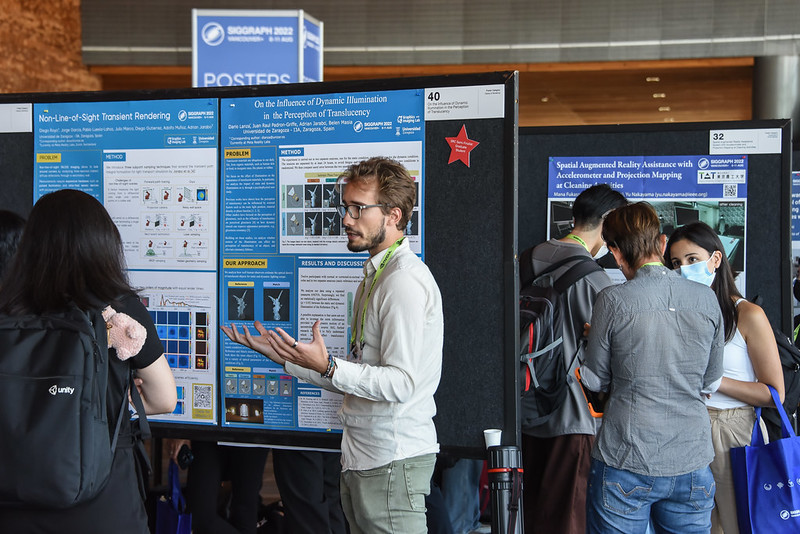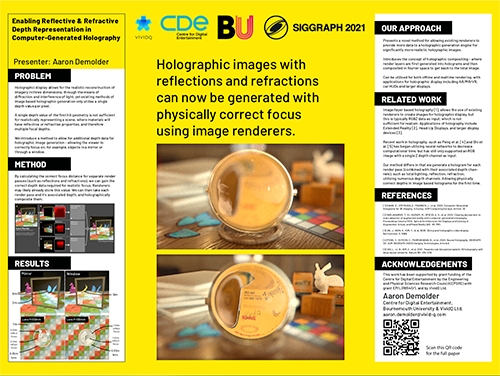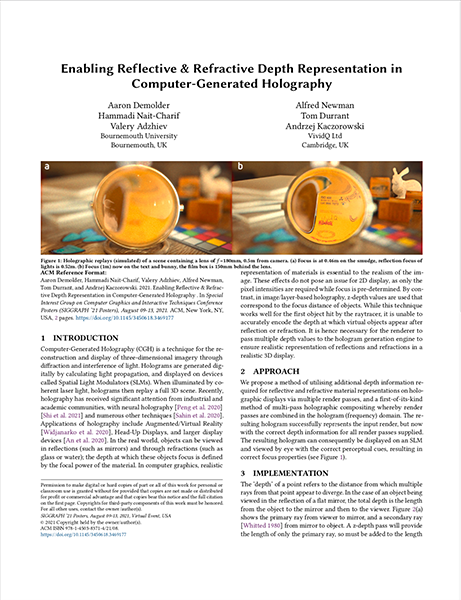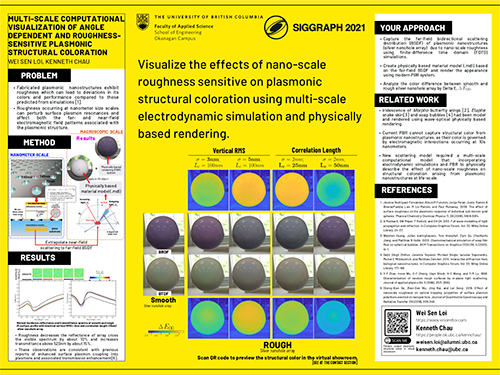Influence and Impact
Posters
Students, academics, artists, enthusiasts, and practitioners are invited to present their latest breakthroughs and ongoing advancements in this forum designed for discussion, inspiration, and networking.
To explore SIGGRAPH 2023 content in detail, please review Posters’ listing on the ACM Digital Library.

Submit to Posters
The SIGGRAPH Posters program is an interactive forum where students, researchers, artists, enthusiasts, and practitioners present their latest novel ideas and ongoing research. Posters authors discuss their work, receive feedback, inspire and find inspiration from others, and network with researchers and industry professionals.
Posters are shown at all times in a dedicated space at the conference, with timed poster sessions when authors talk to attendees. Select posters also participate in the Technical Papers discussion sessions.
Student authors are encouraged to submit to the Student Research Competition for the chance for their work to be highlighted, to receive a prize, and to progress to the ACM Student Research Competition Grand Finals!
Accepted posters will be published in the ACM Digital Library.
How to Submit
Relevant Topics
SIGGRAPH 2023 Posters accepts submissions that explore traditional topics in computer graphics and interactive techniques, and in exciting new topics and applications in the field such as:
- Adaptive and Assistive Technologies: New ways computer graphics and interactive techniques can help alternatively abled people in their day-to-day lives.
- Augmented, Mixed, and Virtual Reality: Innovations and interactive techniques in tomorrow’s virtual and augmented realities.
- Computer-aided Design (CAD) and Fabrication: Presentation of new ideas in CAD with practical applications to engineering, manufacturing, architectural rendering, and geometric design, among others.
- Media Production: Ideas and applications in service of movie, TV, or media productions.
- Games and Interactive Media: Techniques used in the development of content or experiences.
- Generative Machine Learning: Using data and generative models to aid human creativity.
- Human Experience: Health, home, and entertainment. The internet of things, the quantitative self, and immersive technologies have matured, and new data systems that support these innovations make way for more invention and interconnectedness.
- Mobile Devices: Innovations and interactive techniques in mobile graphics.
- Social Good: New ideas on how to use graphics and interactive techniques to help fight misinformation like deep fakes, climate change, or to improve diversity, equity, and inclusion in our representations.
- Visualization: New approaches in computer-generated visual imagery and design in science, education, medicine, and visual analytics.
- Unique: Perhaps your work does not fit into a traditional category — that’s great too!
Submission
Log in to the submission portal, select the “Make a New Submission” tab, and then select the Posters submission form. To preview the information you need to submit, view the Sample Submission Form.
In particular, please note these fields:
- Abstract: Two-page limit. A paper that describes the work that will be presented in your poster.
- Submission categories and keywords: These help to assign appropriate jury members for review.
- Video (Optional): 30 second limit. This helps to demonstrate animation, simulation, interaction, or performance qualities, and is essential to the reviewers in such cases. Depending on on-site facility, this may also be included in a program reel displayed near the physical posters at the conference.
- Supplemental material (Optional): A zip file containing any other material to aid review.
Note: No poster is required at submission time. If your work is accepted, then we will provide further instructions closer to the conference for how to produce your poster.
Posters Accepts Relevant Already-Published Works From Other Fields
For example, a poster describing work already published in a cognitive science journal that brought novel ideas to the SIGGRAPH community could be accepted, and would be reviewed by the Jury for its contribution. Works already presented at small workshops or colloquia within the computer graphics and interactive techniques communities could also be accepted. However, the program does not accept work that has already been accepted as a publication within the computer graphics and interactive techniques communities. For example, a poster describing work already published in the journal Transactions on Visualization and Computer Graphics would not be accepted, nor would a poster describing work published at the Eurographics Symposium on Rendering.
English Review Service
Poster submissions may use the English Review Service and submit by 10 April 2023.
If the English Review Service does not complete their work by the Posters submission deadline, then there is no extension. The English Review Service makes no guarantee for service turnaround, and is administered separately from the conference program. For the best chance of having your submission reviewed by the English Review Service on time, please make sure it is submitted and marked “complete” in the submission system at least 14 days before the submission deadline.
Poster Submission
For 2023, we will use vertical format posters. Your printed poster should be no more than 3.5 feet wide x 4 feet long (~1 meter wide x 1.2 meters long).
When planning your poster layout and content, we recommend that you avoid making it too dense and detailed. Bear in mind that during large poster sessions there is rarely enough time for attendees to read all of the information pertaining to the work described in a poster; posters should then maximize the amount of insight for attendees that may have only very little time to devote to a single poster. Your design should make it easy for a casual passer-by to extract the core message from a quick glance, and only provide detailed information on the side or as a weblink for interested parties.
Please find examples of poster abstracts in the ACM Digital Library in the Posters sections of past SIGGRAPH Proceedings. See here for 2022. We have also selected two examples below from 2021.
Formatting and Templates
Abstract
Your abstract must be no more than two pages in length, including references. Your abstract must conform to the ACM formatting guidelines using these templates and instructions. ACM provides both LaTeX and Word templates, and we recommend that you use the LaTeX template. This is in two-column format.
Abstracts should include author name and affiliation as the review process is single blind.
Microsoft Word template users: The Word template provided by ACM is single column. If your work is accepted, then you will transform your final paper from the Word template into a two-page two-column format PDF as described in this process. Given that the single column format is less dense, Word template submissions may be longer (~three pages; see ‘One Column or Two?’ example) under the constraint that they must be later processable into a two-column two-page format that still includes all Jury-reviewed information.
Poster
Your poster can be designed in any way that you wish, so long as it conforms to the physical size requirements. These will be communicated closer to the conference.
During a large poster session, there is not enough time for attendees to read all of the information described in all posters. One strategy is for posters to provide a key insight for attendees with little time to devote to a single poster, with more detail provided to the side. As guidance, we have provided a vertical template.
Evaluation
Review Process
The review process is conducted by the Posters Jury, which is a panel of experts chosen by the Posters Chair. This process is single blind. Each submission is reviewed by three highly-knowledgeable reviewers. One reviewer is assigned as the primary reviewer and is a member of the Posters Jury, and two additional tertiary reviewers are external to the Posters Jury. One tertiary is invited by the Posters Chair and the other is invited by the primary reviewer. Then, the primary and tertiary reviewers write their reviews. After the reviews are completed, the Posters Jury meets to determine the accept/reject decisions. During this period, a second Jury member is assigned to each submission to assess the reviews and decisions, and to provide an additional opinion as needed. Submission authors receive back the review notes from the jurors, and all submissions discussed at the Posters Jury meeting also receive a short summary review for the decision.
Example Evaluation Criteria:
Concept
How coherently does the submission convey its overall concept? Is the concept similar to existing ones, or does it stand out? This criterion is particularly applicable to submissions that combine existing technologies into a new product (e.g., demos, animations, art pieces). Such submissions are evaluated on both the final product and how well the proposed technologies integrate to meet the desired concept.
Novelty
How new are the ideas in this work? Is it a ground-breaking approach to an old problem, or is it an existing approach with a new twist? The submission must demonstrate to the jury that the approach is sufficiently different from existing approaches.
Evaluation
The submission should be evaluated with respect to other approaches: How is it conceptually different? By how much is it faster or easier to use? Does it give more accurate results? This evaluation must convince the Jury that the solution works. This could be with qualitative, numerical, and/or user testing results. Many submissions are rejected because the submission materials did not convince the jury that the improvements were substantial enough.
Completeness
Many submissions are rejected because, while the problem and solution seemed interesting, the materials did not convince the jury that the solution had actually been implemented and evaluated.
Clarity
How well-written is the abstract? How easy-to-follow are the supporting materials? The abstract must effectively communicate both the problem and the solution in enough detail that the jury can evaluate it. If your submission has an animation, simulation, or interactive component, then a clear video is essential.
Interest
Will conference attendees want to see this? Will it inspire them? Are the results or approach appealing to a broad SIGGRAPH audience? A submission in a niche area is more likely to be accepted if the results are exceptionally better than what exists already or if the proposed solution is applicable to other areas.
Upon Acceptance
Publication Rights and the ACM Rights Management Form
If your work is accepted for presentation at SIGGRAPH 2023, you must complete the ACM Rights Management Form. Within 72 hours of notification of acceptance, submission authors will receive an email from “rightsreview@acm.org” with information about and a link to your work’s rights form. When your rights form has been delivered to ACM, you will then receive an email from “tapsadmin@aptaracorp.awsapps.com” with information about the preparation and delivery of your material to TAPS for publication. Please make sure that emails from “rightsreview@acm.org” and “tapsadmin@aptaracorp.awsapps.com” are part of the “allow list” in your email program so that you do not miss these email messages.
Your representative image and text may be used for promotional purposes. Several SIGGRAPH 2023 programs — Appy Hour, Art Gallery, Art Papers, Computer Animation Festival, Real-Time Live!, Technical Papers, and all installation programs — will prepare preview videos for pre-conference promotion of accepted content, which may include a portion of the material you submitted for review.
Preparing Final Materials
If your work is accepted, you will need to:
- Complete any revisions to your two-page abstract. The source of your abstract (LaTeX or Word) and any supplemental materials must be delivered to TAPS, ACM’s article production system. TAPS will generate the PDF and HTML5 versions of your abstract for publication in the ACM Digital Library. Information about the preparation and delivery of your final material to TAPS can be found at https://homes.cs.washington.edu/~spencer/taps/taps.html. Resolve any formatting issues identified by TAPS or by the proceedings production editor.
- Complete any revisions to your video and supplemental material.
- Prepare a poster describing your work. Contributors should only present accepted, Jury-reviewed content, not new content.
Camera ready submission
- 9 June 2023: Finalize basic information about your work in the Linklings submissions portal. This information is used to present your work at the conference and in the ACM Digital Library.
- 20 June 2023: Submit the final abstract and final poster to TAPS.
- 20 June 2023: Submit the final video and final supplementary material to Linklings.
If we do not receive your final abstract and poster by 20 June 2023, you will not be allowed to present at SIGGRAPH 2023.
Student Research Competition
If you requested entry into the ACM Student Research Competition and your poster is accepted, it will be passed to the Student Research Competition Jury for consideration. You will be contacted separately by the Student Research Competition Chair before the conference.
At the Conference In Person
Presenting a poster in person at SIGGRAPH 2023 in the Los Angeles Convention Center requires that:
- You are responsible for printing, bringing, and hanging your poster by the start of the conference.
- We cannot print your poster or accept shipments.
- Student Volunteers will be available in the Posters area to provide assistance.
- Poster sessions: You must be available to present your poster during the Posters presentation sessions.
- Technical Papers sessions: Select posters will be presented during the Technical Papers/Art Papers Q&A sessions as part of the in-person conference experience. These posters will be selected by the Posters Chair based on thematic similarities between the poster topics and the Technical Papers/Art Papers session themes.
- We encourage you to bring a portable computer to demo your work. Outlets for power are not available. Small tables may be available in limited quantities on a first-come, first-served basis.
- Posters are displayed in an unsecured area; do not leave valuable equipment unattended.
Presenter Recognition
If your work is accepted for presentation at SIGGRAPH 2023, one contributor from each submission must be registered at a registration level that provides access to the Posters program. Each submission is given one discount registration rate.
You can find a link to the contributor recognition policy here.
ORCID Mandate
ACM requires that all accepted contributors provide valid ORCID identifiers prior to publication. Corresponding contributors are responsible for collecting these ORCID identifiers from co-contributors and providing them to ACM as part of the ACM eRights selection process.
You and your co-contributors can create and register your ORCID identifier at https://orcid.org/register. ACM only requires you to complete the initial ORCID registration process. However, ACM encourages you to take the additional step to claim ownership of all of your published works via the ORCID site.
Timeline
25 April 2023, 22:00 UTC/GMT
Posters submission deadline.
Second Week in June 2023
Acceptance or rejection notices are sent to submission authors. Additional scheduling and submission information is sent to authors of accepted submissions.
9 June 2023
Deadline for changes to basic information for publication, including speakers, descriptions, and the representative image.
20 June 2023
Final poster and final two-page abstract submitted to TAPS. Final video and supplemental material submitted to Linklings.
4 August 2023
Official publication date.
Note: The official publication date is the date the proceedings are made available in the ACM Digital Library. This date may be up to two weeks prior to the first day of your conference. The official publication date affects the deadline for any patent filings related to published work. (For those rare conferences whose proceedings are published in the ACM Digital Library after the conference is over, the official publication date remains the first day of the conference.)
6–10 August 2023
SIGGRAPH 2023. Posters should be put up by 4 pm on Saturday, 5 August. Posters can be taken down after 5:30 pm on Thursday, 10 August.






